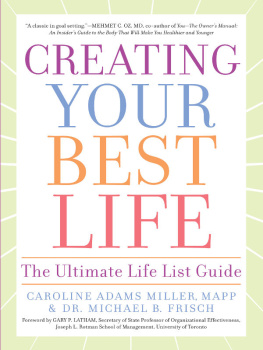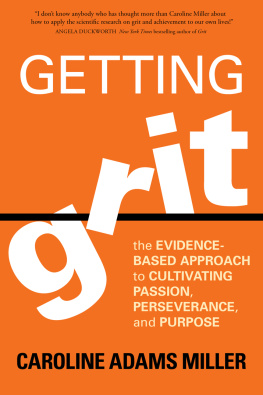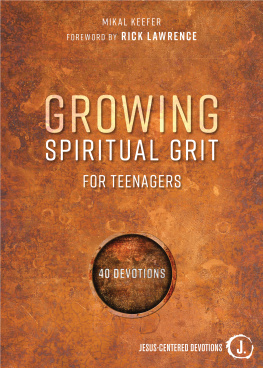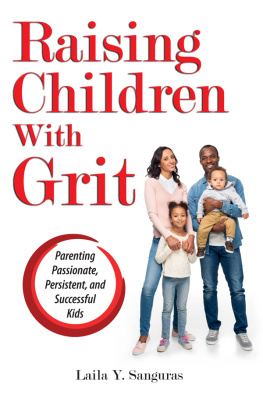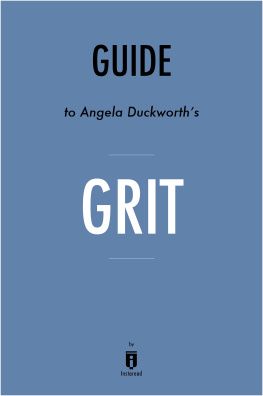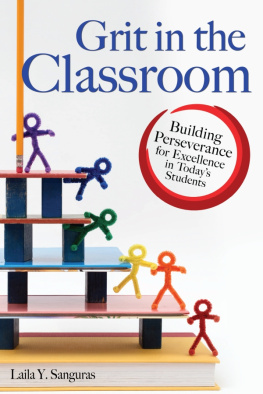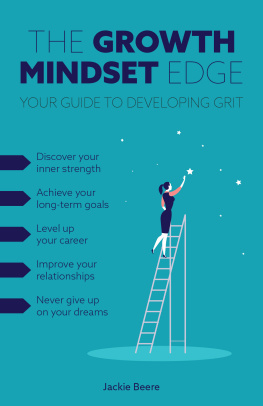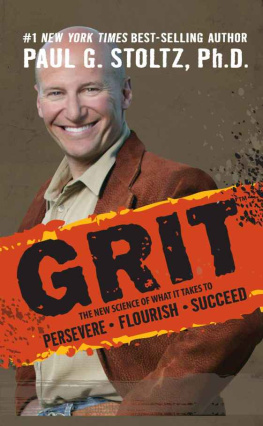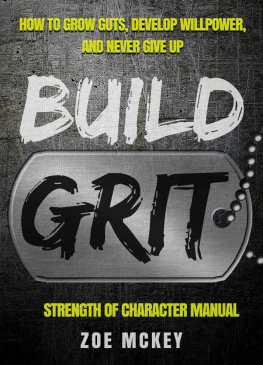
To all of the wise, wonderful, recovering people in my first
twelve-step community, whose role modeling, friendship,
and mentoring gave me the necessary ingredients to
build authentic grit. My gratitude is boundless because
I was given hope, which gave me back my life.
Contents
Introduction
i n 2012, my oldest son, Haywood, graduated college with a degree in accounting. To select the right university for his strengths and interests, he followed his major consuming passion, swimming. He started at the University of Maryland on a partial scholarship and transferred halfway through, to the University of Cincinnati, so that his best swimming events matched the holes in their roster. His final GPA was okaynot phenomenalso I was a bit surprised when he was asked to interview at almost every major accounting firm in the country.
In the midst of a difficult job market and the lingering effects of the recession, we were prepared for Haywood to have to move home, like so many of his peers. The word on the street was that hed be stymied in getting a job that would allow him to live independently and begin to attack his student loansor to get any job at all. I was happily taken aback when my son immediately landed a job at one of the best accounting firms in the country with a starting salary that made his living alone more than doable.
Curious, I asked him what he thought had made him a winning candidate when the media had painted a picture of a job market so bleak that we all assumed only the cream of the crop from the very top schools would find employment. Haywood mused for a moment, and then answered: I think it was the swimming. The only questions I was really asked to elaborate on were about how many years Id spent practicing, whether it was once or twice a day, the fact that Id competed through college, and that I was elected captain of my college team despite transferring in my junior year. He continued, I think they just wanted to know if I had a work ethic, leadership qualities, and the ability to get along with people, and then added with a laugh, My GPA obviously wasnt the deciding factor!
I shouldnt have been too surprised by his good news in light of the work I do with high-performance individuals around the world on goal-setting and emotional flourishing, but as an anxious mom, I still worried that Haywoods decision to focus on swimming in college may not have been the best idea for his employment future. In this case, though, his desirability mirrored what has increasingly occurred in todays job market, and what I wrote about in my book Creating Your Best Life. In it, I noted that many in the generation of Millennials, raised on mountains of trophies and self-esteem-building ceremonies, were turning out to be a disaster in the working world, and that employers were hiring consultants to coach them on how to work diligently and take feedback when their performance was anything other than awesome.
To avoid these types of problems, firms were increasingly coming up with unique ways to discern which candidates would bring a strong work ethic, good sense of teamwork, and likeability to their company, and not problems that would necessitate firing these employees later. Instead of focusing on GPAs and summer internships, they wanted people like my son, who had nursed a passion for years, and stuck with the activity even when it was difficult and, often, the only reward was the satisfaction of not giving up. The thinking is that if these types of job applicants have already learned how to work hard, overcome disappointment, and persist in the absence of constant praise, then theyll be the kinds of employees who can be trained to do almost anything.
My interest in the topic of grit was ignited during the year I spent at the University of Pennsylvania, from 2005 to 2006, earning one of the first masters of applied positive psychology (MAPP) degrees in the burgeoning field of applied positive psychologythe science of happiness. There, I was introduced to the work of Angela Duckworth, who was pursuing her doctorate under Dr. Martin Seligman on a quality she was calling grit, which she defined as passion and perseverance in pursuit of long-term goals. As someone who had spent several decades writing about and coaching others on how to set and achieve difficult goals, I was mesmerized by the scientific findings I learned at Penn concerning what it takes to be a winner in some of lifes most challenging arenas. I became steeped in concepts like goal-setting theory, self-efficacy theory, and social contagion, and I began to link all of these ideas together in a new way, which morphed from my capstone project into my book Creating Your Best Life. In that book, I included a chapter on Angelas research and findings, which werent generally known outside of academia at that time.
I wrote that Angelas twelve-item Grit Scale had been found to be the leading predictor of who drops out at West Point during the first summer, known as Beast Barracks. It had also worked with preteens, determining who would reach the finals of the National Spelling Bee. Since Creating Your Best Life was published, the Grit Scale has been found to predict tenacity in other difficult situations, too: which men remain married, which inner-city students will complete high school, which cadets will be accepted into the United States Special Operations Forces, and even which economically disadvantaged students will graduate from college.
In the intervening years since I graduated from the MAPP program, Ive worked with thousands of individuals as a professional coach, speaker, and educator. What I have heard and seen, including what I witnessed in my childrens lives as they grew from infancy to adulthood in the middle of the now-maligned self-esteem movement, has convinced me to add my voice and thoughts to the burgeoning field of grit commentary. I am also emboldened to speak up because I see youth and adults who are desperate to learn how to cultivate more grit in themselves, their workplaces, their families, and their communities. They want to help change the current standards of banal mediocrity back to rigorous excellence, but they say they dont know where to start or what to do to make that happen.
I think we can all agree that the world is facing challenges that are daunting and even unprecedented, and that a call for resilience of the highest order is facing us. Roiling international economic markets, random terrorist attacks, and global climate challenges are exacerbated by the twenty-four-hour news cycle that keeps negative news at the forefront at all times. U.S. college students are reporting epidemic levels of anxiety and depression, and on top of that, they are often mired in student-loan debt and negative prognoses about their future earning possibilities. Without grit, how can anyone survive or thrive?
Whats in this book?
In this book, I share research and ideas about how we can boost the character strengths and behaviors that we see in gritty people. Ive even come up with a term that I use to describe the type of grit I think elicits the greatest results: authentic grit. I define this as the passionate pursuit of hard goals that awes and inspires others to become better people, flourish emotionally, take positive risks, and live their best lives.
The book is divided into two parts. The first is about different types of gritboth good and badand how our nation came to embrace and amplify mediocrity in many arenas and what that has left us to work with. The second section covers my observations, experience, and some of the research on how we can build the strengths and actions that comprise authentic grit, such as passion, goal-setting, self-regulation, confidence, risk-taking, and patience, among others. Youll also find exercises throughout these chapterssome for you to use on your own and many you can use in a variety of settings with othersto set goals, develop a resilient mind-set, create winning strategies, assemble supportive teams and communities, and raise standards that awe and inspire others to their own greatness. These are user-friendly ideas and resources that you can use again and again.
Next page

